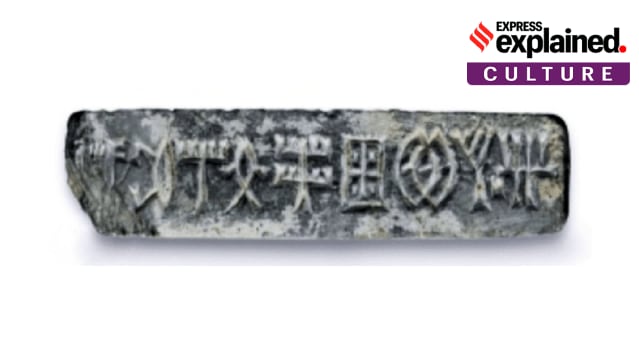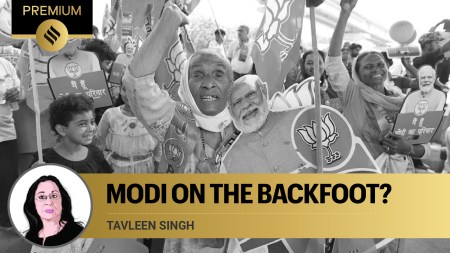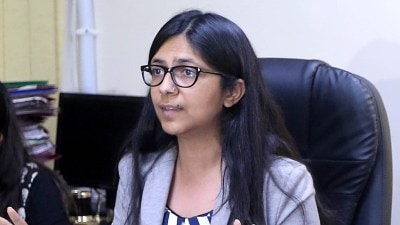- India
- International
Explained: An ancient Dravidian language link with Indus Valley civilisation
A new research paper published in the peer-reviewed journal of the Springer Nature Group has provided some interesting new insight on the linguistic culture of the Harappans.
 Indus script recovered from Khirsara, Indus Valley civilisation. (Photo: Wikimedia Commons)
Indus script recovered from Khirsara, Indus Valley civilisation. (Photo: Wikimedia Commons)What language did the inhabitants of the Indus Valley Civilisation (IVC) communicate in? Scholars of history and archaeology have been asking this question ever since the Bronze Age civilization was discovered back in the mid-19th century. The Indus Valley script is yet to be deciphered.
A new research paper published in the peer-reviewed journal of the Springer Nature Group has provided some interesting new insight on the linguistic culture of the Harappans. Taking clues from a few words shared between the Indus Valley people and the cultures they came in contact with, the paper traced their language roots to proto-Dravidian, which is the ancestral language of all the modern Dravidian languages. Thereafter the paper suggested that speakers of ancestral Dravidian languages had a greater historic presence in northern India including the Indus Valley region from where they migrated.
What are the findings of the paper?
The paper titled, ‘Ancestral Dravidian languages in Indus Civilization: ultraconserved Dravidian tooth-word reveals deep linguistic ancestry and supports genetics’ has been written by software developer and independent researcher Bahata Ansumali Mukhopadhyay.
The study took into account the thriving trade relations between the Indus Valley Civilisation (IVC) and the Persian Gulf as well as Mesopotamia. Accordingly, Mukhopadhyay searched through the near-Eastern texts to locate foreign words with roots in the Indus Valley. The logic, as the paper suggests, is the fact that when a commodity is not locally produced, we call it by its foreign name.

Consequently, the study found that the Akkadian (language spoken in ancient Mesopotamia) word for elephant- ‘pīru’/‘pīri’ and their variations, as well as the old Persian word for ivory, ‘pīrus’ possibly had roots in the Indus Valley. “My study argues that since archaeological data strongly associates Near Eastern ivory-objects of middle-third to early-second millennium BC with Asian elephants and IVC traders , and since the ivory-words (e.g., ‘ab’, ‘abu’, ‘ȧb’, ‘beḥu’, ‘netcheḥ-t’) used in ancient Egypt (the only other major source of prehistoric ivory), has no phonetic connection to ‘pīru’, these ‘pīru’-based words could likely have originated in IVC,” wrote Mukhopadhyay in the paper.
Further, the paper suggested that in several Dravidian languages, ‘pīlu’, ‘pella’, ‘palla’, ‘pallava’, ‘piḷḷuvam’, ‘pīluru’ are used to signify elephant. Mukhopadhyay pointed out to the discrepancy between the use of ‘l’ in the Indic languages and ‘r’ in Akkadian and old Persian and suggested that “since people of ancient Persia had functioned as intermediaries between Mesopotamia and IVC traders, while exporting IVC’s ivory, they had arguably spread the Indic elephant word (‘piru’ ‘pilu’) to Mesopotamia as well.”
On tracing the etymology of the words further, the paper explained that they are connected with the root words for tooth in the Dravidian languages- ‘pal’, ‘pella’, ‘pallu’, ‘palu’, which are unmistakably related to the words that mean elephant or elephant tusk, that is, ‘pīlu’, ‘pillakā’, ‘palla’, ‘pella’. Commenting upon how elephant’s another moniker, ‘dantin’ or ‘tooth-haver’ in Sanskrit is rooted in the Indo-Aryan and Indo-Iranian word for tooth, ‘danta’, the paper suggested that “the relation between Proto-Dravidian tooth-word and the Dravidian ‘pal’/‘pīl’-based elephant-words must be deeply etymological, not accidental.”
The paper provided another piece of evidence connecting ‘pilu’ with the words used for tooth in proto-Dravidian. Several Indic words refer to the ‘Salvadora persica’ (better known as the toothbrush tree in the western world and as ‘Miswak’ in Arabic speaking countries since its branches are used as a natural toothbrush) as ‘pilu’. This suggests that just like the elephant word- pilu, the name used for the tree too is rooted in the proto-Dravidian word for tooth.
Mukhopadhyay further wrote that “Indian epic Mahābhārata (Ganguli, 1883–96) frequently associates the ‘pīlu’ tree with regions of Indus river basin, proving that the ‘pīlu’ phytonym was prevalent in Indus valley since antiquity.”
Taking into account the multiple pieces of evidence, the paper concluded that the basic vocabulary items of a significant population of the Indus Valley Civilisation must have been proto-Dravidian, or that ancestral Dravidian languages must have been spoken in the Indus Valley region.
How do the findings of the paper develop our understanding of the Indus Valley Civilisation?
The paper corroborated similar arguments made by a few scholars in the past, particularly that of Asko Parpola, an indologist at the University of Helsinki. Parpola in his work published in 2010 mapped the symbols used in the Indus Valley script and connected them to words used in modern Dravidian languages. Based on this he concluded that the underlying language of the Indus script was Proto-Dravidian.
Mukhopadhyay’s study comes soon after a recent genetic study published in peer reviewed journal ‘Science’ in 2019 which made a case for the spread of proto-Dravidian languages from the areas of northwestern India to southern India. The paper titled ‘The formation of human population in South and Central Asia’ suggested that after the decline of the Indus Valley Civilisation, groups from north and north western India speaking a proto-Dravidian language moved south and east. “A possible scenario combining genetic data with archaeology and linguistics is that proto-Dravidian was spread by peoples of the IVC along with the Indus Periphery Cline ancestry component of the ASI (Ancestral South Indian). Nongenetic support for an IVC origin of Dravidian languages includes the present-day geographic distribution of these languages (in southern India and southwestern Pakistan) and a suggestion that some symbols on ancient Indus Valley seals denote Dravidian words or names,” said the paper.
“So one could say that based on the cumulative evidence that has now become available in terms of linguistics, genetics and archaeology, the rational and parsimonious explanation for the spread of Dravidian languages in India is a movement of people from northwestern India to southern India,” said Tony Joseph who has authored the book, ‘Early Indians’ (2018). Joseph says the common understanding is that this movement happened after the decline of the Harappan civilisation in 1900 BCE, but in his book he argued why this movement could have begun somewhat earlier”.
Mukhopadhyay emphasised on the fact that proto-Dravidian was perhaps one among several languages being spoken in the Indus Valley region. She noted that Dravidian group languages, despite being spoken mainly in southern India “also have scattered representations in India’s North-Western (Brahui), North-Eastern (Kuṛux, Malto), and Central (e.g., Kolami, Naiki, Parji, Ollari, Gadaba) parts, indicating that Dravidian speakers possibly had much greater pre-historic presence in Northern India, including IVC regions”.
Joseph explained that the statement made by the recent paper on Dravidian languages being spoken in the Harappan civilisation, “is in conformity with the latest genetic study which revealed that some of the Harappan migrants whose ancient DNA had been recovered from the Indus Periphery ‘carried the Y-chromosome haplogroup H1a1d2 which today is primarily found in southern India”. The possible implication of this finding is that there was a population movement from northwestern India to south India”. Joseph also said that while the new study makes no comment on Indo-European languages, it is not in conflict with the dominant academic understanding that the migration of Indo-European language speakers to India happened approximately between 2000 BCE and 1500 BCE when the Harappan Civilisation was in decline. In other words, the Arya-Sanskrit-Vedic culture came after the Harappan Civilisation and while it is a significant and important constituent of Indian civilisation, it is not the earliest source of it.”
Newsletter | Click to get the day’s best explainers in your inbox
More Explained
EXPRESS OPINION
May 17: Latest News
- 01
- 02
- 03
- 04
- 05













































